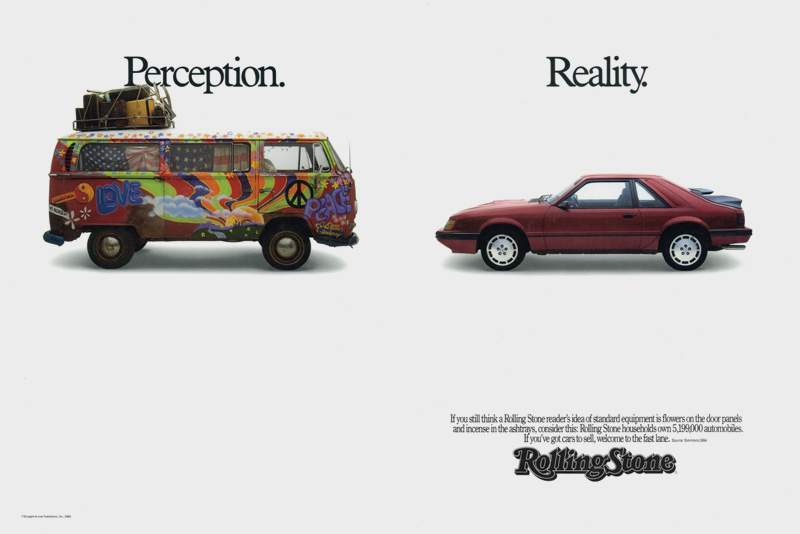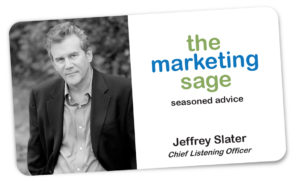Remember the old Rolling Stone campaign about perception versus reality?
The ad ran in Ad Age and other trade publications in 1970. Rolling Stone was getting started and wanted to convince advertisers that their readers weren’t poor hippies but were actual well-to-do yuppies with lots of money to spend on cars, vacation, and expensive whiskey.

Advertisers had one perception about who was reading the publication, yet the facts were different. In this case, Rolling Stone put the advertiser’s perception (hippie) next to the reality (yuppie) and backed it up with solid audience research. It helped fuel enormous growth and success by addressing this market myth. There is an excellent lesson in this story.
Perception versus Reality
This ad always reminds me of how a marketing department is the listening department when it is doing its job. They must serve as the organization’s ears, hearing from the market the objections that keep coming up.
Marketing teams must be like independent sponges absorbing misperception about your product and services. You must bring in the bleach to wipe away the viral and bacterial lies infecting your brand.
Perhaps your brand has been positioned by a competitor, and you are fighting an inaccurate portrayal of what you do and how misunderstood your product is with customers. Someone must take up the charge to convince consumers or your business customers to see you clearly that doesn’t cast a shadow on the value you can bring to them.
I like to think of this work as a myth-busting.
I have some suggestions that can help you examine these problems in your business.
First: Survey your sales team to ask them the top 3 reasons for not making a sale besides price. You will learn a lot as you start collecting these objections. Write down all the complaints you hear from your sales team.
Here are a few examples to illustrate the concept.
- The product we sell isn’t as robust as the competitors
- Our service isn’t as reliable as the competition
- Our new products don’t perform as we say in our ads
- We are cheap and inexpensive quality, so we don’t deserve a higher price
- Our product is in the cheap segment of the market- there is no way we will get used in the more expensive part of the industry
- We are as polluters where our competitors are supportive of environmental issues
Second: Survey people who are industry thought leaders like journalists, bloggers, and authors- to name a few, who have strong opinions and influence in your industry’s marketplace. Ask them to give you their perception of your company (product and service). Have them describe to you how they view your business. Ask them to use one or two words to describe your product or offer. Add any new thoughts or perceptions to your list from sales.
- Your company has an inconsistent performance record
- People who work at your company tend to be arrogant
- Your last new product was a flop, yet you didn’t recall it from the marketplace and stuck customers with the problem
- Your warranty is weak compared to everyone in the industry
- In a word, your company/product/service is:
- Inconsistent
- Cheap
- Overpriced
- Arrogant
- Ineffective
Third: Assemble the company’s critical management team and examine each of these objections, qualifier words or positioning statements and ask the hard question-is any of this stuff, right?
Or is this a misperception?
Look for common themes and take each objection and see if you can honestly, without bias, deny the charge. Is the statement correct, false, or somewhere in between? You have, to be frank about this, or you are just deluding yourself into believing your “crap.” (crap is a technical marketing term that I don’t think needs explanation.)
Fourth: Pull out of the list all the objections that are just false, and you are confident that you have data to counter-argue your case. Next, look at those objections that may only be misunderstood and need repositioning in your customers’ minds. At this point, the marketing team should start sorting the list of myths that you need to bust and prioritize them. This step aims to focus on the top 3 myths that are the essential perceptions to alter. Don’t tackle everything at once.
Fifth: Now, take each of these three significant myths and talk to customers and stakeholders and ask, what would convince you that the following legend is false? If you can read about this myth without being defensive and listen carefully, some tactical ideas will emerge to help you bust this myth.
The marketing team’s role is to determine how to best communicate to your different audiences the counterarguments that can change from a perception of reality. Marketing must take up the sword to fight back.
The fun part of this work is determining the best way to illustrate or demonstrate the myth’s opposite to bring customers closer to reality. Rolling Stone brilliantly illustrated their problem with two photographs showing what the advertiser saw versus what the truth looked like. Sometimes a focused approach to establishing the data can work- but you must communicate it in a way that can get through to your audience.
Simple ideas are always best, and usually, you must fight one myth at a time.
A brochure or video that counters the perception needs to focus on one argument on a single topic. Don’t expect to fight all your myths with one sword.
MYTH: YOUR PRODUCT IS ONLY GOOD FOR CHEAP PRODUCTS, NOT EXPENSIVE ONES
If your products or services are perceived to be in cheap market segments, how can you overwhelm customers with examples where your product or service appears as the more expensive part of the market? The solution might be to inundate them with evidence of the opposite. Show them a tsunami of examples to counter this falsehood. They believe one thing but shine a light on the information they aren’t seeing.
MYTH: YOUR PRODUCT IS UNRELIABLE:
If your product is unreliable, but you know this is not true, how can you offer the customer a guarantee that knocks their socks off and takes their breath away. Be audacious. Let the guaranty reflect your confidence in the product’s reliability.
(Hint: If you are afraid to do this- maybe the perception is accurate, and you need to fix the product.)
MYTH: YOUR PRODUCT IS A POLLUTER:
If your product’s perception is as a polluter or a bad steward of the planet, how can you shine a light on the truth? It may require a change in your honest, transparent attitude, and forces you to change your tone. Demonstrate this newfound attitude and help illustrate the record, which may not be perfect, but might be much better than people think. And it can demonstrate your commitment to change.
Myths. If you don’t fight them, you will eventually accept someone else’s perception of your company. Listen. Act. Take up the sword of truth.
Okay, time to go bust a few myths.
Need help busting a few myths?
I can help. You can set up a time chat with me about your marketing challenges using my calendar. Our initial conver?sation is free. You talk, I listen. Email me jeffslater@themarketingsage.com or call me. 919 720 0995. Visit my website at www.themarketingsage.com. Let’s explore working together today.

Photo Courtesy of Rolling Stone Magazines Advertising
Photo by bruno neurath-wilson on Unsplash
This popular post apppeared previously on the Marketing Sage Blog.




